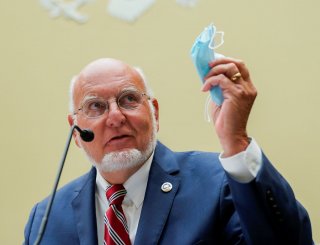CDC Advises People Not to Wear Masks With Vents or Valves
Just don't do it. Here's why.
The Centers for Disease Control and Prevention has released new guidance that advises people not to wear face masks with vents or exhalation valves.
The agency is still encouraging the public to wear face masks and coverings in public spaces to limit the spread of the novel coronavirus. However, health officials have noted that vents and valves could allow the virus to escape the mask.
“Masks with one-way valves or vents allow exhaled air to be expelled out through holes in the material,” the CDC wrote on its website.
“This can allow exhaled respiratory droplets to reach others and potentially spread the COVID-19 virus.”
Last month, CDC Director Robert Redfield asserted that if every American decided to wear a mask or face covering, the United States could get the coronavirus pandemic under control within two months.
“The time is now,” Redfield said during an interview with the Journal of the American Medical Association’s Dr. Howard Bauchner.
“I think if we could get everybody to wear a mask right now—I think in four, six, eight weeks we could bring this epidemic under control.”
Medical experts have noted that the virus can spread through respiratory droplets that pass when an infected person coughs or sneezes. Recent studies have suggested that not wearing a face mask dramatically increases a person’s chance of being infected by the coronavirus.
“We conclude that wearing of face masks in public corresponds to the most effective means to prevent interhuman transmission, and this inexpensive practice, in conjunction with simultaneous social distancing, quarantine and contact tracing, represents the most likely fighting opportunity to stop the COVID-19 pandemic, prior to the development of a vaccine,” one recent study published in the Proceedings of the National Academy of Sciences said.
Other experts have claimed that the coronavirus could spread through aerosolized droplets, particularly in poorly ventilated spaces. According to the World Health Organization, airborne transmission refers to the presence of extremely small particles that can remain in the air for long periods of time and has the potential to be transmitted to others over distances greater than one meter.
For even better protection against the contagion, White House coronavirus advisor Dr. Anthony Fauci recently suggested that people should wear goggles or an eye shield in addition to a face mask or covering.
“Theoretically, you should protect all of the mucosal surfaces (eyes, nose, mouth), so if you have goggles or an eye shield, you should use it,” the director of the National Institute of Allergy and Infectious Diseases said in an interview with ABC News on Instagram.
Fauci called the use of goggles and eye shields as “perfect protection” from COVID-19, but also noted that it’s not “universally recommended.”
There are now more than 20.1 million confirmed cases of coronavirus worldwide, including at least 738,000 deaths, according to the latest data from Johns Hopkins University.
The United States has the most cases, with nearly 5.2 million confirmed infections and more than 164,000 deaths.
Ethen Kim Lieser is a Minneapolis-based Science and Tech Editor who has held posts at Google, The Korea Herald, Lincoln Journal Star, AsianWeek and Arirang TV. Follow or contact him on LinkedIn.
Image: Reuters

